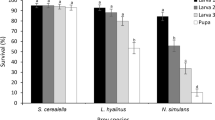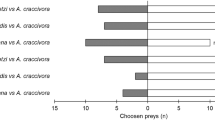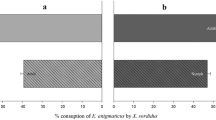Abstract
Halyomorpha halys (Stål, 1855) is an invasive pest causing serious damage to agricultural crops in Europe and the USA. Very little is known about H. halys predators in Europe. This survey evaluated the potential of generalist predators/omnivorous species by means of predation bioassays in tri-dimensional arenas, where the predator had to locate H. halys prey items on the leaves of a bean plant. Eleven species of different taxa were tested and the prey items consisted in fresh eggmasses, 1st and 2nd instar nymphs. One species was also tested against adults. Some predators were species commercially available as biocontrol agents against plant pests, other predators were wild, captured in habitats shared with H. halys. All tested specimens were starved 24 h before starting the experiment. The survivorship of control prey items in predator-excluding cages was compared to that of predator treatment groups to determine the effect of predator presence. According to the results, the generalist species showed a quite low acceptance of H. halys prey items, since only two species caused 80% mortality on at least one item (Eupholidoptera chabrieri and Rhynocoris iracundus) and mortality due the other species never exceed 60%. Among commercially available species only Adalia bipunctata adults and Chrysoperla carnea larvae were effective, predating the eggs and 1st instar nymphs, respectively. Among the field collected specimens, the orthopteran E. chabrieri and the predatory hemipterans R. iracundus, Nagusta goedelii and Himacerus mirmicoides showed efficacy against 1st instar nymphs, E. chabrieri and R. iracundus showed efficacy against 2nd instar nymphs, whereas only E. chabrieri and N. goedelii predated the eggs. R. iracundus was also tested on the adults and successfully predated them. By identifying some of the species that can exploit H. halys as a suitable prey in southern Europe, the present investigation provides an important contribution for conservation biological control of this pest.



Similar content being viewed by others
References
Abram PK, Doyon J, Brodeur J, Gariépy TD, Boivin G (2014) Susceptibility of Halyomorpha halys (Hemiptera: Pentatomidae) eggs to different life stages of three generalist predators. Can Entomol 147(02):222–226
Abram PK, Hoelmer KA, Acebes-Doria A, Andrews H, Beers EH, Bergh JC, Bessin R, Biddinger D, Botch P, Buffington ML, Cornelius ML, Costi E, Delfosse ES, Dieckhoff C, Dobson R, Donais Z, Grieshop M, Hamilton G, Haye T, Hedstrom C, Herlihy MV, Hoddle MS, Hooks CRR, Jentsch P, Joshi NK, Kuhar TP, Lara J, Lee JC, Legrand A, Leskey TC, Lowenstein D, Maistrello L, Mathews CR, Milnes JM, Morrison WR III, Nielsen AL, Ogburn EC, Pickett CH, Poley K, Pote J, Radl J, Shrewsbury PM, Talamas E, Tavella L, Walgenbach JF, Waterworth R, Weber DC, Welty C, Wiman NG (2017) Indigenous arthropod natural enemies of the invasive brown marmorated stink bug in North America and Europe. J Pest Sci 90(4):1009–1020
Acebes-Doria AL, Leskey TC, Bergh JC (2017) Temporal and directional patterns of nymphal Halyomorpha halys (Hemiptera: Pentatomidae) movement on the trunk of selected wild and fruit tree hosts in the mid-Atlantic region. Environ Entomol 46(2):258–267
Arellano R, Medal J, Arellano G, Pérez J (2019) Feeding responses of Euthyrhinchus floridanus (Hemiptera: Pentatomidae) to brown marmorated stinkbug (Hemiptera: Pentatomidae) adults and nymphs. Fla Entomol 102(3):658–659
Biddinger DJ, Surcică A, Joshi NK (2017) A native predator utilising the invasive brown marmorated stink bug, Halyomorpha halys (Hemiptera: Pentatomidae) as a food source. Biocontrol Sci Technol 27(7):903–907
Borges M, Aldrich JR (1992) Instar-specific defensive secretions of stink bugs (Heteroptera: Pentatomidae). Experientia 48(9):893–896
Bretz F, Hothorn T, Westfall P (2011) Multiple comparisons using R. Chapman & Hall/CRC, Boca Raton
Castracani C, Bulgarini G, Giannetti D, Spotti FA, Maistrello L, Mori A, Grasso DA (2017) Predatory ability of the ant Crematogaster scutellaris on the brown marmorated stink bug Halyomorpha halys. J Pest Sci 90:1181–1190
Cesari M, Maistrello L, Piemontese L, Bonini R, Dioli P, Lee W, Park CG, Partsinevelos GK, Rebecchi L, Guidetti R (2018) Genetic diversity of the brown marmorated stink bug Halyomorpha halys in the invaded territories of Europe and its patterns of diffusion in Italy. Biol Invasions 20(4):1073–1092
Cornelius ML, Dieckhoff C, Hoelmer KA, Olsen RT, Weber DC, Herlihy MV, Talamas EJ, Vinyard BT, Greenstone MH (2016) Biological control of sentinel egg masses of the exotic invasive stink bug Halyomorpha halys (Stål) in Mid-Atlantic USA ornamental landscapes. BioControl 103:11–20
Costi E, Haye T, Maistrello L (2017) Biological parameters of the invasive brown marmorated stink bug, Halyomorpha halys, in southern Europe. J Pest Sci 90(4):1059–1067
Costi E, Haye T, Maistrello L (2019) Surveying native egg parasitoids and predators of the invasive Halyomorpha halys in Northern Italy. J Appl Entomol 143(3):299–307
CSO Italy (2020) Estimation of damage from brown marmorated stink bug and plant pathologies related to climate change. https://www.csoservizi.com
Dioli P (2013) Presenza in Italia di Nagusta goedelii (Kolenati, 1857) e note sulla sua biologia ed ecologia (Hemiptera: Heteroptera: Reduviidae). Onychium 10:32–39
Faúndez EI, Rider DA (2017) The brown marmorated stink bug Halyomorpha halys (Stal, 1855) (Heteroptera: Pentatomidae) in Chile. Arq Entomolóxicos 17:305–307
Hamilton GC (2009) Brown marmorated stink bug. Am Entomol 55:19–20
Haridass ET, Morrison MN, Balu A (1988) Predatory behaviour of Rhinocoris marginatus Fabricius (Harpactorinae–Reduviidae–Heteroptera–Insecta). Proc Indian Acad Sci (Anim Sci) 97(1):41–48
Haye T, Gariepy T, Hoelmer K, Rossi JP, Streito JC, Tassus X, Desneux N (2015) Range expansion of the invasive brown marmorated stinkbug, Halyomorpha halys: an increasing threat to field, fruit and vegetable crops worldwide. J Pest Sci 88(4):665–673
Haye T, Fischer S, Zhang J, Gariepy T (2015) Can native egg parasitoids adopt the invasive brown marmorated stink bug, Halyomorpha halys (Heteroptera: Pentatomidae), in Europe? J Pest Sci 88(4):693–705
Hoebeke ER, Carter ME (2003) Halyomorpha halys (Stål) (Heteroptera: Pentatomidae): a polyphagous plant pest from Asia newly detected in North America. Proc Entomol Soc Wash 105(1):225–237
Hothorn T, Bretz F, Westfall P (2008) Simultaneous inference in general parametric models. Biom J 50(3):346–363
Inaturalist (2020) https://www.inaturalist.org/taxa/81923-Halyomorpha-halys
Jones AL (2013) Indigenous natural enemies of the invasive brown marmorated stink bug, Halyomorpha halys (Hemiptera: Pentatomidae). Master of Science, Department of Entomology, University of Maryland, College Park
Lattin JD (1999) Bionomics of the Anthocoridae. Annu Rev Entomol 44(1):207–231
Lee DH, Short BD, Joseph SV, Bergh JC, Leskey TC (2013) Review of the biology, ecology, and management of Halyomorpha halys (Hemiptera: Pentatomidae) in China, Japan, and the Republic of Korea. Environ Entomol 42(4):627–641
Lee DH, Nielsen AL, Leskey TC (2014) Dispersal capacity and behavior of nymphal stages of Halyomorpha halys (Hemiptera: Pentatomidae) evaluated under laboratory and field conditions. J Insect Behav 27(5):639–651
Lee DH, Leskey TC (2015) Flight behavior of foraging and overwintering brown marmorated stink bug, Halyomorpha halys (Hemiptera: Pentatomidae). Bull Entomol Res 105(5):566–573
Lesaffre E, Albert A (1989) Partial separation in logistic discrimination. J Royal Stat Soc Series B Methodol 51(1):109–116
Leskey TC, Short BD, Butler BR, Wright SE (2012) Impact of the invasive brown marmorated stink bug, Halyomorpha halys (Stål) in mid-Atlantic tree fruit orchards in the United States: case studies of commercial management. Psyche J Entomol. https://doi.org/10.1155/2012/535062
Maistrello L, Dioli P, Bariselli M, Mazzoli GL, Giacalone-Forini I (2016) Citizen science and early detection of invasive species: phenology of first occurrences of Halyomorpha halys in Southern Europe. Biol Invasions 18:3109–3116
Maistrello L, Vaccari G, Caruso S, Costi E, Bortolini S, Macavei L, Foca G, Ulrici A, Bortolotti PP, Nannini R, Casoli L, Fornaciari M, Mazzoli GL, Dioli P (2017) Monitoring of the invasive Halyomorpha halys, a new key pest of fruit orchards in Northern Italy. J Pest Sci 88(1):37–47
Maistrello L, Dioli P, Dutto M, Volani S, Pasquali S, Gilioli G (2018) Tracking the spread of sneaking aliens by integrating crowdsourcing and spatial modeling: the Italian invasion of Halyomorpha halys. BioScience 68(12):979–989
Moraglio ST, Tortorici F, Pansa MG, Castelli G, Pontini M, Scovero S, Visentin S, Tavella L (2020) A 3-year survey on parasitism of Halyomorpha halys by egg parasitoids in northern Italy. J Pest Sci 93(1):183–194
Morrison WR, Mathews CR, Leskey TC (2016) Frequency, efficiency, and physical characteristics of predation by generalist predators of brown marmorated stink bug (Hemiptera: Pentatomidae) eggs. BioControl 97:120–130
Morrison WR, Bryant AN, Poling B, Quinn NF, Leskey TC (2017) Predation of Halyomorpha halys (Hemiptera: Pentatomidae) from web-building spiders associated with anthropogenic dwellings. J Insect Behav 30(1):70–85
Ogburn EC, Bessin R, Dieckhoff C, Dobson R, Grieshop M, Hoelmer KA, Mathews C, Moore J, Nielsen AL, Poley K, Pote JM, Rogers M, Welty C, Walgenbach JF (2016) Natural enemy impact on eggs of the invasive brown marmorated stink bug, Halyomorpha halys (Stål) (Hemiptera: Pentatomidae), in organic agroecosystems: a regional assessment. BioControl 101:39–51
Poley K (2017) Biological control of Halyomorpha halys (Hemiptera: Pentatomidae) using native natural enemies in Michigan. Master thesis, Michigan State University, Michigan
Poley K, Bahlai C, Grieshop M (2018) Functional response of generalist predators to Halyomorpha halys (Hemiptera: Pentatomidae) Eggs. Environ Entomol 47(5):1117–1127
Pote JM, Nielsen AL (2017) Life stage specific predation of Halyomorpha halys (Stål) by generalist predators. BioControl 114:1–7
R Core Team (2019) R: A language and environment for statistical computing. R Foundation for Statistical Computing, Vienna, Austria. https://www.r-project.org/
Rice KB, Bergh CJ, Bergmann EJ, Biddinger DJ, Dieckhoff C, Dively G, Herbert A (2014) Biology, ecology, and management of brown marmorated stink bug (Hemiptera: Pentatomidae). J Integr Pest Manag 5(3):A1–A13
Rieger C (1972) Zu Rhynocoris Hahn, 1833 (Heteroptera). Deut Entomol Z 19(1–3):15–20
Roy HE, Brown PMJ, Adriaens T, Berkvens N, Borges I, Clusella-Trullas S, Comont RF, De Clercq P, Eschen R, Estoup A, Evans EW, Facon B, Gardiner MM, Gil A, Grez AA, Guillemaud T, Haelewaters D, Herz A, Honek A, Howe AG, Hui C, Hutchison WD, Kenis M, Koch RL, Kulfan J, Handley LL, Lombaert E, Loomans A, Losey J, Lukashuk AO, Maes D, Magro A, Murray KM, Martin GS, Martinkova Z, Minnaar IA, Nedved O, Orlova-Bienkowskaja MJ, Osawa N, Rabitsch W, Ravn HP, Rondoni G, Rorke SL, Ryndevich SK, Saethre M, Sloggett JJ, Soares AO, Stals R, Tinsley MC, Vandereycken A, Wielink P, Vigla´sˇova´ S, Zach P, Zakharov IA, Zaviezo T, Zhao Z, (2016) The harlequin ladybird, Harmonia axyridis: global perspectives on invasion history and ecology. Biol Invasions 18(4):997–1044
Rutledge CE, O'Neil RJ, Fox TB, Landis DA (2004) Soybean aphid predators and their use in integrated pest management. Ann Entomol Soc Am 97(2):240–248
Shanovich HN, Aukema BH, Koch RL (2020) Natural enemy community composition and impact on brown marmorated stink bug (Hemiptera: Pentatomidae) eggs in Minnesota apple orchards. Environ Entomol 49(2):324–333
Stopbmsb (2020) https://www.stopbmsb.org/where-is-bmsb/
Suckling DM, Burnip GM, Hackett J, Daly JC (2006) Frass sampling and baiting indicate European earwig (Forficula auricularia) foraging in orchards. J Appl Entomol 130(5):263–267
Wiman NG, Walton VM, Shearer PW, Rondon SI, Lee JC (2015) Factors affecting flight capacity of brown marmorated stink bug, Halyomorpha halys (Hemiptera: Pentatomidae). J Pest Sci 88(1):37–47
Taylor CM, Coffey PL, DeLay BD, Dively GP (2014) The importance of gut symbionts in the development of the brown marmorated stink bug, Halyomorpha halys (Stål). PLoS One 9(3):e90312
Acknowledgements
The authors are grateful to Joshua Gearing for English editing. The work was partially funded by the Emilia Romagna region, within the Rural Development Plan 2014–2020 Op. 16.1.01-GO-PEI-Agri-FA 4B, Pr. «HALYS», coordinated by CRPV.
Author information
Authors and Affiliations
Corresponding author
Ethics declarations
Conflict of interest
The authors declare that there are no known conflicts of interest associated with this publication.
Research involving human and/or animal rights
This article does not contain any studies with human participants or animals (vertebrates) performed by any of the authors.
Additional information
Handling Editor: Eric Riddick.
Rights and permissions
About this article
Cite this article
Bulgarini, G., Badra, Z., Leonardi, S. et al. Predatory ability of generalist predators on eggs, young nymphs and adults of the invasive Halyomorpha halys in southern Europe. BioControl 66, 355–366 (2021). https://doi.org/10.1007/s10526-020-10066-3
Received:
Accepted:
Published:
Issue Date:
DOI: https://doi.org/10.1007/s10526-020-10066-3




